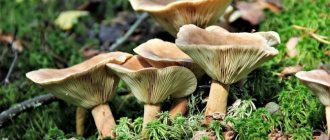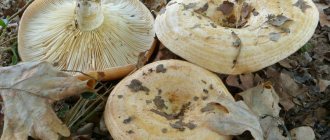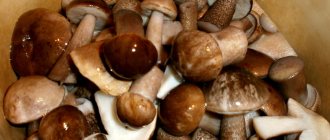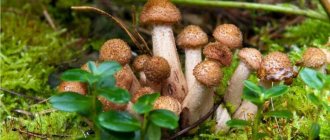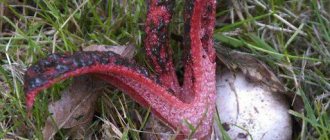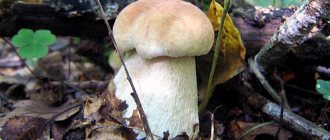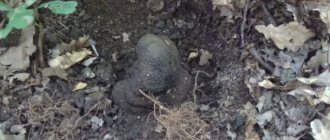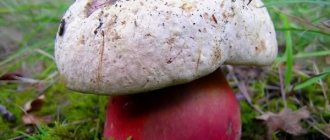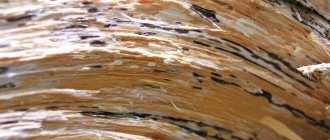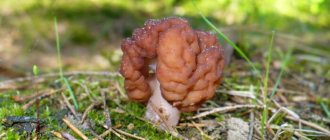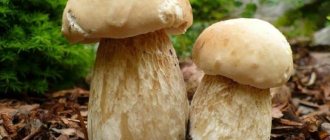Fringed star or sessile earth star (Geastrum fimbriatum) is a species of mushroom from the genus Geastrum of the family Geastraceae. The species is inedible, but some people like to take the dried earth star home as a curious souvenir of nature.
The species is easily recognized because the exoperidium splits radially into rays, forming a star-shaped structure at maturity. The rays wrap around the spore ball until rain or high humidity causes it to swell and collapse, lifting the ball off the ground and allowing the spores to be dispersed by air currents. The rays dry out and fold when the air dries out.
Where does fringed starflower grow?
The fringed star is primarily a forest mushroom that lives in deciduous, coniferous and mixed forests. The earth star prefers sandy, loamy, clay and calcareous soils. The fungus also grows on peat bogs, in dry to more or less wet places. The sessile earth star does not like marshy areas and low-lying peat bogs.
Starweed fringed forms a mycosis with deciduous trees (birch, beech, hawthorn, maple, oak, sea buckthorn) and coniferous trees (abies, pinus).
The fringed star mushroom is one of the most common and widespread fungi of the more than 15 species of terrestrial stars known in Europe. It grows mainly near the stumps of deciduous trees. Found in Asia, Mongolia, eastern North America including Mexico, Central America and South America (Brazil).
Flower type ritual gupna. Magical plants and features of their use
- What magical energy do plants carry?
How to choose magical plants for your home so that they bring benefits
What plants carry the energy of wealth?
What magical plants will protect you from the evil eye and damage?
What plants will help reveal magical abilities?
What plants can't be grown at home?
Even in ancient times, people learned to use the magical properties of plants to achieve their goals. It has been observed that some flowers and herbs help achieve success, heal from illnesses or protect against the effects of negative energy. The energy of correctly collected witchcraft plants is very powerful. Magical plants can restore a person’s strength and restore his joy of life.
How to choose magical plants for your home
The energy of indoor flowers is of great importance for creating an atmosphere of comfort in the house. Many of them carry positive energy, but some also carry negative energy.
There are female and male plants, and the balance of their ratio in the house is very important. If there are approximately equal numbers of them, then the general atmosphere in the house and the relationship between the owners will be harmonious.
It is best to grow flowers with rounded leaves, because this shape smoothes out and eliminates any negativity.
The energy of houseplants can influence the following aspects of life:
- On the general atmosphere in the house. Magical plants absorb negativity and all negative influences. As a result, the atmosphere of the home is cleansed.
For the health of the household. Flowers help cure many diseases.
To attract various benefits and success.
For love. There are plants that have magical properties to attract a soul mate and strengthen relationships between people.
For protection from theft, from disease, from evil forces, from witchcraft.
Magical indoor plants that bring good luck
- Spathiphyllum.
This flower is popularly called “Women’s Happiness” for its ability to improve the climate in the family and maintain well-being. It is suitable for cultivation by single women and those who, while already married, often quarrel with their spouse.
- Violet.
The violet is the flower of the world. In a family where they like to grow these plants, quarrels and conflict situations between household members are very rare. In addition, the violet is considered a symbol of fidelity. If you want to get rid of mental suffering, then plant a white flower. In any case, if a dark streak has come in your life, violet will help you overcome it.
- Chinese rose (hibiscus).
The Chinese rose is featured on the emblem of Hawaii and is also the symbol of Malaysia. In addition, her ability to establish peace in the family was noticed. It can also increase passion.
- Wax ivy, hoya.
In many countries, this flower is used as a living “Valentine”, because the presentation of this magical plant symbolizes a declaration of love. If you want to grow hoya in your apartment, it is best to place it in the bedroom.
- Myrtle.
The magical properties of this indoor plant allow you to achieve mutual understanding and peace in the house. It will become an indispensable gift for any family celebration.
- Aichrizon.
This is a very unusual magical plant to grow in your home. Among its properties is the ability to attract love and happiness into family relationships.
- Calathea.
This plant has become widely known for its ability to have a positive effect in extreme family situations. If a couple is on the verge of breaking up and marital happiness is in jeopardy, give them a calathea. And then people’s chances of maintaining relationships will increase significantly.
- Chlorophytum.
The outwardly unpresentable chlorophytum is known for its air purifying abilities. By placing this flower in a room after renovation, you will quickly get rid of all unpleasant odors. No less effectively, it removes harmful substances released into the atmosphere by low-quality furniture.
In addition, its properties in maintaining peace in the family were noticed. Even in an office space, chlorophytum is able to maintain a friendly atmosphere, preventing quarrels.
- Oxalis (Oxalis).
Growing sorrel at home is recommended for anyone who wants to meet their other half. The magical properties of the plant will definitely help you find true love.
- Anthurium.
Anthurium is popularly called “Male Happiness” due to its ability to restore and maintain potency in males. It is advisable to place this magical plant in the bedroom.
- Akalitha.
Description of fringed starwort
The fruiting bodies of Geastrum fimbriatum begin to grow in roughly spherical and hypoid shapes. As the mushroom ripens, it pushes through the soil
and breaks up to form 5 to 8 rays that bend downward. Fully
the body of the expanded fruit has a diameter of up to 3 cm. Before expansion, the outer surface has a cottony surface with adhering soil particles. The rays eventually peel off to reveal a smooth, grayish brown.
Unlike other similar starburst mushrooms, the edges of the pores are not
sharply demarcated from the rest of the spore sac and without grooves. The fruiting bodies do not have a characteristic taste or smell.
The spores are spherical, roughened with many small dots or warts, and measure 2.4–4 µm. The capillium is thick-walled, unbranched, 4–7 µm thick.
Application of the mushroom
The benefits of earthen stars are closely related to their use. They do not contain toxic substances and are similar to raincoats. They are rarely used as food: they do not have a pronounced taste or smell. These mushrooms are not boiled first.
In folk medicine, the star and its spores are more popular. They found practical applications:
- the body of a young starfish, cut into plates, replaces the plaster and dressing material, because it successfully stops bleeding and can help speed up wound regeneration;
- Powder is made from mature spores; it is also added to medicinal tinctures;
- Geastrums, or starbursts, are rich in chemical components, therefore extracts from them are used as antiseptics and antitumor agents.
Life cycle of fringed starwort
Earth's stars spend much of the year as mycelium that burrows into the soil, digesting decaying organic material. When ready to reproduce, the mycelium develops an “earth star” above the ground. The "ball" is actually a spore sac. When immature, the spore sac inside is solid, but when mature, the inside turns into a mass of powdery spores. When raindrops hit the ball, spores are released from a pore at the top of the bag.
First described in 1829, this species has a wide distribution and is found in Asia, Europe and America. It is distinguished from other terrestrial stars by the fine fibers that line the circular pore at the top of its spore sac.
Types of mushroom
Types of starfish are divided into 2 main groups. Some mushrooms are eaten at a young age, while others are not suitable for cooking. Old eukaryotes of any kind do not eat: they lose their attractiveness, become hard and tasteless, but they acquire other useful properties.
Inedible starfish species
Geastrums are for the most part not edible, although they have interesting external features. They are not poisonous mushrooms either. Inedible starfish are used in folk medicine. They have several types with their own characteristics:
- Triple starfish: in its appearance there are features that somewhat distinguish it from its brothers. It has a double layer of outer shell (peridium), the upper part of which bursts into several unequal parts, and the inner part forms a cup around the spore-bearing body. A kind of belt is formed along the upper part of the spherical sac with spores, called a courtyard. The color of the mushroom body can take on beige or light brown shades.
- Striped starwort: the young fruiting body is located underground and resembles a bulb in shape. As the mushroom matures, the body of the mushroom spreads long, creamy, star-shaped lobes that crack and darken over time. The spore-bearing body has a small diameter, an elongated shape, and sits on a small thick stalk. It is gray in color, covered with a whitish coating, the tip at the apex is characterized by clearly defined stripes, hence the name of the species. The main difference between the species is the location of the mycelium - on the surface of the soil, and, as is “accepted”, in the soil.
- Starwort crowned: has gray matte lobes of the outer shell of the mushroom body. The spore-bearing part rises on an elongated neck. But the leg is missing. The color of the ball is much darker than the star-like part of the geastrum, more reminiscent of a brown tint.
- Starweed fringed: partially showing its fruiting body from the ground. The outer shell (pridium) has a yellowish-brown tint, breaks into 5-7 lobes, which are strongly curved downwards. The spore-bearing ball is gray in color and has a faintly outlined yard. When looking at the fungal body from above, you can clearly see along the edges of the lobes a kind of denser fringe formed from the upper layer of the peridium.
- Small starfish: this species is called the smallest representative of the Geaster family. The lobes of the upper layer of the mushroom body crack into 8-12 equal parts in a horizontal plane, then the mushroom body rises slightly upward. The color scheme of the star's petals is closer to beige-gray; over time, cracks appear with lighter internal contents. The gray spore-bearing ball becomes brown closer to ripening, and the proboscis lengthens at the top. It is interesting that the endoperidium (the inner layer of the shell) is characterized by the presence of a peculiar crystalline coating.
- Black-headed starwort: is a special species. His appearance in youth and maturity can be said to be strikingly different. When the mushroom body is still young, it resembles an ordinary raincoat of light or slightly brownish color. As it ripens, the outer shell bursts into 5-8 parts, exposing the spore-bearing ball. The inner part of the rays of the star and the top itself are covered with a fairly thick layer of dark, often black, mature spores, which are immediately carried away by wind and rain.
- Four-lobed starwort: during the ripening and opening of the “petals”, it also raises the body above the ground. The color of the outer layer is gray-white, and the spore-bearing ball is dark gray. A special feature of eukaryotes is the pronounced flattened rim around the hole at the top of the ball - the courtyard.
Conditionally edible mushrooms
Only young mushrooms are suitable for consumption.
Young mushrooms from the Geasteraceae family are eaten as an exotic additive. These species are rare. In a state of physiological maturity, mushrooms are no longer suitable for consumption.
- Vaulted starwort: is one of the rarest species, characterized by a flattened or spherical underground body. When the top layer is separated, ingrown fragments of litter remain on the visible side of the blades, which create the appearance of cascades and canopies. The color of the outer part is brown, the spore-bearing ball is flattened, fawn-colored, matte.
Irina Selyutina (Biologist):
The vaulted starwort is characterized by the presence in its chemical composition of a number of biologically active substances that are beneficial to the human body. For its development, this type of starweed prefers carbonate soils, i.e. soils that contain carbonates - salts of carbonic acid H2CO3.
Starberry is eaten (without prior boiling or frying) only at very early stages of development - when its fruiting body resembles a ball in appearance. But since at this time it is almost completely immersed in the soil, finding it is very problematic.
- Schmiedel's starwort: the second edible representative of the genus. The fruiting body of this eukaryote is small in size; during ripening it cracks and rises upward. The ball is located on a short stalk and has large cilia around the spore opening. The entire “star” is brown and darkens as it ages.
Etymology
The word "Geastrum", the generic name of the mushroom, comes from the Greek "Geo", which means "earth", and "astrum" translates to "star", so "Geastrum" means "earth star". The specific epithet "fimbriatum" is a Latin translation of "fibrous" or "fringed" - a description of the fringed opening of the peristome (spore); The English word fimbriate is also used to describe the way the ends of a flower petal divide into two or more divisions. A synonym for the specific epithet sessile, by which this earth star was until recently more widely known, means "sitting."
Option 2: Stewed cabbage with mushrooms and meat - quick recipe
The following dish is affordable and easy to prepare; you can safely start your home recipe notebook with it. We cook in a slow cooker, which means that the automation will take on some of the hassle, proceed with confidence, mistakes are excluded with this recipe.
Ingredients
- 600 gram slice of white cabbage;
- 300 grams of pork trimmings;
- large white onion;
- a third of a glass of refined oil;
- salt and a couple of pinches of pepper;
- half a spoonful of tomato;
- five juicy feathers of young onions;
- champignons, fresh - 200 grams;
- water;
- ground coriander.
How to quickly prepare delicious stewed cabbage with mushrooms
The mass of cabbage indicated in the list of ingredients is taken without the stalk and rough outer leaves. Remove them and only then weigh the remaining part or immediately chop the vegetable, and take only the required amount of straws. After adding a little salt, crush the cabbage with your hands and repeat this procedure after about ten minutes; add the released moisture to the dish during the stewing process.
From the multicooker panel, start the frying program and pour a little oil into the bowl. While the vegetable fat is heating up, cut the pork into cubes and dissolve the peeled onion into small pieces. Place the chopped products in a bowl and fry until amber in color, then salt and sprinkle them with pepper. If necessary, wash the mushrooms and dry them with a napkin. Coarsely chop them directly into the bowl and mix with the meat and onions for about three minutes.
Place the cabbage sticks in the slow cooker along with the juice that has come out, add boiling water and mix the ingredients. We set the extinguishing mode for 40 minutes, and on the clock we count down half that time. Lower the lid of the device. After 20 minutes, mix the cabbage with coriander and tomato, close the multicooker again and wait until the program stops. Season the finished dish with chopped herbs.
Wonderful snack
Where else can you use canned nameko mushrooms in everyday life? Recipes for salads with them differ little from the options familiar to our people. One of them requires the presence of such products as 300 grams of canned mushrooms, an egg, a small onion, vegetable oil, a tablespoon of vinegar (or mayonnaise).
Preparing this dish only takes a few minutes:
- First you need to boil the egg.
- At this time, you can chop the onion and open a jar of mushrooms. Those who don't like slippery nameko can pre-boil them. In this case, the mucus will go into the broth, and the mushrooms will remain soft and aromatic.
- Collect all ingredients in a salad bowl and mix thoroughly. If mayonnaise is used as a dressing, then vegetable oil is no longer required.
If the dish is being prepared for a holiday table, it can be served in improvised plates made from the peels of exotic fruits, or placed on lettuce leaves. This unusual approach to serving is sure to please guests.
Puff pastry envelopes
Puff pastry envelopes with mushrooms can be prepared as a separate dish or as an appetizer. They are served both cold and hot, and they are easy and quick to prepare.
Ingredients:
- puff pastry – 200 g;
- potatoes – 2 pcs.;
- hard cheese – 100 g;
- champignons – 300 g;
- garlic – 4 cloves;
- butter – 30 g;
- onion – 1 pc.;
- Provençal herbs, salt, ground black pepper - to taste.
Boil the potatoes in their skins, cool, peel, and cut into medium-sized cubes. Grind the cheese on a grater. Chop the mushrooms and onions, pass the garlic through a press.
First, fry the garlic in butter for 1 minute, then add the onion, champignons, and fry until the moisture has evaporated. Add potatoes, salt, pepper, herbs, stir. Roll out the dough, cut into squares, place the filling in the center of each, and sprinkle with cheese on top. Fold into an envelope: fold one edge, then 2 side edges, brush with egg. Bake at 200°C for 15 minutes.
